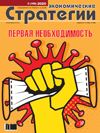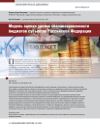Model of Assessing the Balance of the Budgets of Subjects of the Russian Federation
DOI: 10.33917/es-3.169.2020.24-29
Over the past decade, new trends have emerged, political and technological, which will set the conditions for the development of global economic processes in the near future. Within the framework of the modern paradigm, qualitative economic growth is possible only in the case of large-scale introduction of innovations and digital technologies, which is possible while ensuring macroeconomic stability. The article discusses the issues of quantitative assessment, based on the developed economic and mathematical model, the level of budget balance of the constituent entities of the Russian Federation. When forming the model of the category “macroeconomic stability”, the methods of regression, correlation and factor analysis were used. An index method has been used as a quantitative assessment tool. A calculation-experimental method was used to prove the realism of the developed model, and to give a quantitative assessment using examples of constituent entities of the Russian Federation that are part of the Volga and Siberian federal districts. The results obtained develop scientific knowledge in the field of regional economics, and their practical use will allow to purposefully and reasonably solve the problems of regional and leading development management.
References:
1. Interv’yu Prezidenta Rossiiskoi Federatsii Putina V.V. kitaiskim sredstvam massovoi informatsii [Interview with President of the Russian Federation Putin V.V. Chinese media]. RIA Novosti, 2018, June, 6, available at: https://ria.ru/20180606/1522142937.html.
2. Aganbegyan A.G. Analiz i prognozirovanie sotsial’no-ekonomicheskogo razvitiya regionov Rossii (metodicheskie zametki) [Analysis and rorecasting of socio-economic development of regions (methodical notes)]. Srednerusskii vestnik obshchestvennykh nauk, 2019, no 4, pp. 15–28, DOI: 10.22394/2071-2367-2019-14-4-15-28.
3. Kvint V.L. Kontseptsiya strategirovaniya [Strategy Concept]. Vol. 1. Saint Petersburg, SZIU RANKhiGS, 2019, 132 p.
4. Halkos G., Tzeremes N.G., Kourtzidis S.A. Regional sustainability efficiency index in Europe: an additive two-stage DEA approach. Operational Research, 2015, vol. 15, pp. 1–23.
5. Lengyel I. Competitiveness of Metropolitan Regions in Visegrad Countries. Procedia-Social and Behavioral Science, 2016, vol. 223, pp. 357–362.
6. Galiullina G.F. Model’ upravleniya territoriyami operezhayushchego sotsial’no-ekonomicheskogo razvitiya [Territories of Advanced Socio-Economic Development: a Model of Management]. Problemy sovremennoi ekonomiki, 2018, no 1, pp. 99–103.
7. Piskun E.I., Khokhlov V.V., Karuna K.I. Metodologicheskie aspekty upravleniya razvitiem regionov v usloviyakh tsifrovizatsii [Methodological Aspects of Regional Development Management During the Digitization]. Regional’naya ekonomika: teoriya i praktika, 2019, no 1, pp. 4–15.
8. Rasporyazhenie Pravitel’stva RF ot 13 fevralya 2019 g. N 207-r “Strategiya prostranstvennogo razvitiya Rossiiskoi Federatsii na period do 2025 goda“ [Order of the Government of the Russian Federation of February 13, 2019 No. 207-r ”Spatial Development Strategy of the Russian Federation for the Period Until 2025”], available at: http://government.ru/docs/35733/
9. Yakovlev V.P. Ekonometrika [Econometrics]. Moscow, Dashkov i K°, 2017, 383 p.
10. Statistika [Statistics]. Ofitsial’nyi sait Federal’noi sluzhby gosudarstvennoi statistiki, available at: https://www.gks.ru/statistic.



